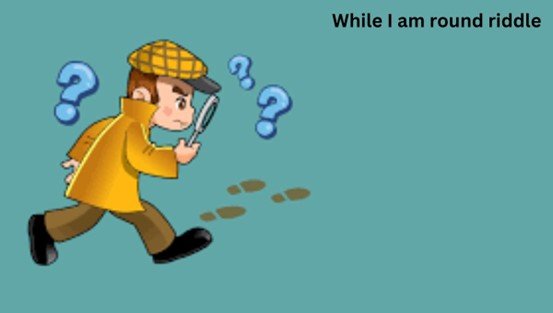Introduction to the Riddle
Riddles have captivated the human mind for centuries, serving as both entertainment and mental exercise. One such riddle, “While I Am Round,” invites us to explore its meaning and unravel its mystery. This riddle, with its seemingly straightforward phrasing, challenges us to think beyond the obvious. Let’s delve into the intricacies of this riddle and understand why it continues to intrigue.
What is the “While I Am Round” Riddle?
Understanding the Structure of the Riddle
At its core, the riddle “While I Am Round” is designed to engage your thinking processes. The phrase suggests a quality or state related to being round, which can be interpreted in various ways. The simplicity of the riddle is deceptive; it requires a deep understanding of both literal and metaphorical meanings.
Origins of Riddles in Human Culture
Riddles have a rich history across different cultures. From ancient Greece to modern times, they have been used to entertain, educate, and challenge people. The “While I Am Round” riddle fits into this tradition, serving as a mental puzzle that encourages lateral thinking and problem-solving.
Analyzing the Phrase “While I Am Round”
Breaking Down the Clues in the Riddle
The phrase “While I Am Round” implies that the answer has something to do with the shape or quality of being round. This could refer to an object with a circular shape, or it could be a metaphor for something else entirely. To solve the riddle, one must consider both literal and figurative meanings.
The Role of Shape and Form in Riddles
Shapes and forms are often used in riddles to convey abstract concepts. In this case, “round” could symbolize completeness, continuity, or even cyclical processes. Understanding the role of shape in riddles helps in deciphering their meanings and finding solutions.
Common Interpretations of the Riddle
The Literal Interpretation of “Round”
When taken literally, “round” describes objects with a circular shape. This could include everyday items like wheels, coins, or the moon. The literal interpretation suggests that the answer might be something physical that fits this description.
Symbolic Interpretations of the Phrase
Symbolically, “round” can represent cycles or recurring patterns. For instance, the concept of time is often depicted as a circle, representing the ongoing nature of days and seasons. This symbolic meaning adds a layer of complexity to the riddle, making it more challenging to solve.
Why Do Riddles Matter in Modern Culture?
Riddles as Brain Teasers and Mental Exercises
Riddles are more than just puzzles; they are exercises for the brain. Solving riddles helps improve cognitive functions such as memory, concentration, and problem-solving skills. They provide a fun way to challenge the mind and keep it sharp.
The Psychological Benefits of Solving Riddles
Engaging with riddles has psychological benefits beyond cognitive improvement. They can reduce stress, enhance creativity, and boost mood. The sense of accomplishment from solving a riddle can also provide a feeling of satisfaction and confidence.
The Role of Riddles in Language Development
Enhancing Problem-Solving Skills through Riddles
Riddles encourage individuals to think critically and approach problems from different angles. This enhances problem-solving skills by fostering creative thinking and analytical reasoning.
Building Vocabulary and Cognitive Abilities
Riddles often use clever wordplay and unusual phrases, which can help expand vocabulary and improve comprehension. They challenge individuals to understand and manipulate language in novel ways, thereby boosting cognitive abilities.
Historical Significance of Riddles
Ancient Riddles and Their Influence on Modern Puzzles
Riddles have a long history, with some of the earliest examples found in ancient literature. For instance, the riddle of the Sphinx in Greek mythology is one of the most famous. Its influence can be seen in modern puzzles and riddles, which often draw on similar themes and structures.
Famous Riddles from Literature and Folklore
Throughout history, riddles have appeared in various literary and folkloric contexts. The riddle of the Sphinx, which asks about the creature that walks on four legs in the morning, two in the afternoon, and three in the evening, is a prime example. Such riddles have left a lasting impact on storytelling and puzzle-solving traditions.
A Deeper Dive into the “Round” Concept
How Circles Represent Time and Continuity
The circle is a powerful symbol in many cultures, representing continuity, eternity, and the cyclical nature of time. In the context of the riddle, this symbolism adds depth to the interpretation of “round,” suggesting that the answer may involve concepts related to time or ongoing processes.
Mathematical and Geometric Aspects of “Round”
From a mathematical perspective, the concept of “round” is closely related to geometry. Circles have unique properties and mathematical significance, such as the constant ratio of the circumference to the diameter (π). Understanding these aspects can provide additional insights into the riddle.
Popular Riddles Similar to “While I Am Round”
Exploring Riddles with Circular or Geometric Themes
Riddles that involve shapes and geometry often play with the properties of circles and other forms. For example, a riddle might describe an object that is round and has specific characteristics, challenging solvers to identify it based on these clues.
The Universal Appeal of Shape-Based Riddles
Shape-based riddles have a universal appeal because they tap into fundamental concepts that are easily recognizable. Circles and other shapes are common in everyday life, making these riddles accessible and engaging for a wide audience.
Creating Your Own “Round” Riddle
Tips for Writing Effective Riddles
When crafting your own riddle, consider using shapes or forms as a theme. A successful riddle should be intriguing, with a twist that challenges the solver. Focus on clear yet ambiguous clues to create a puzzle that is both fun and thought-provoking.
Understanding the Elements of a Successful Riddle
Key elements of a successful riddle include clarity, ambiguity, and a clever twist. The riddle should provide enough information for the solver to make an educated guess, but also include enough misdirection to keep it challenging.
The Challenge of Solving “While I Am Round”
Why This Riddle Stumps People
The “While I Am Round” riddle can be challenging due to its simplicity. The word “round” may have multiple interpretations, making it difficult to pinpoint the exact answer. The key is to think beyond the obvious and explore various meanings.
Strategies to Approach Similar Riddles
To tackle riddles like “While I Am Round,” start by analyzing the key terms and considering both literal and symbolic meanings. Break down the clues and think about how they might relate to different concepts or objects.
Famous Riddles and Their Solutions
Historical Examples of Tough Riddles
Many famous riddles have stood the test of time due to their complexity and cleverness. For example, the riddle of the Sphinx has intrigued people for centuries with its description of the creature that evolves throughout the day.
How Riddles Influence Popular Culture
Riddles often inspire popular culture, from literature to media. Their ability to engage and challenge people has led to their incorporation in various forms of entertainment, reinforcing their lasting appeal.
Conclusion
The riddle “While I Am Round” exemplifies the complexity and allure of riddles. Its seemingly simple phrasing invites a deeper exploration of shapes, symbols, and meanings. By understanding the historical and cultural significance of riddles, we gain insight into their role in cognitive development and their impact on modern culture. Whether solving or creating riddles, the challenge lies in embracing the nuances and hidden meanings that make these puzzles both captivating and educational.
FAQs
- What is the answer to the “While I Am Round” riddle?
The answer to the “While I Am Round” riddle is often subject to interpretation, but a common solution is “a coin,” which is round and has different meanings based on context. - Why are riddles important in cognitive development?
Riddles enhance cognitive development by stimulating problem-solving skills, critical thinking, and creativity. They provide a mental workout that can improve memory, concentration, and analytical abilities. - Can solving riddles improve creativity?
Yes, solving riddles can boost creativity by encouraging lateral thinking and novel problem-solving approaches. Riddles challenge individuals to think outside the box and consider multiple perspectives. - What makes shape-based riddles so intriguing?
Shape-based riddles are intriguing because they leverage fundamental geometric concepts that are universally recognizable. They engage our understanding of shapes and forms, making them both accessible and thought-provoking. - How can I create my own riddle?
To create your own riddle, start by choosing a theme or concept, such as shapes or objects. Develop clues that are both clear and ambiguous, leading solvers to think critically. Ensure the riddle has a clever twist to make it engaging.

